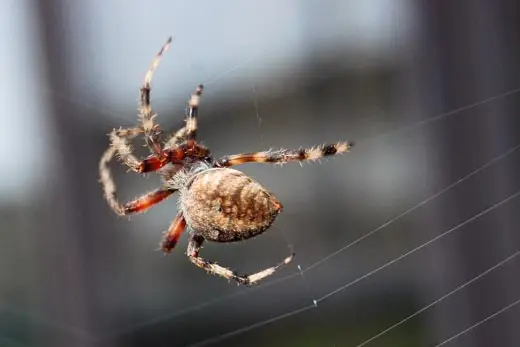
Yikes. The sight of a teeny spider can send many into a panic attack. It’s called “Arachnophobia”. Extreme fear of spiders. It’s easy to understand why spiders scare people. They look ferocious. And centuries of scary myths send many into a screaming frenzy yelling for the family spider killer who squashes the critter.
Most people think spiders are insects, but they are arachnids which resemble insects. Spiders have eight legs versus insects which have six legs. Spiders have two body parts including a head and abdomen. Spiders do not have wings or antennae. They are closely related to ticks and scorpions. Spiders feed on insects, related arthropods and even other spiders.
There over 35,000 species of spiders with about 3,000 existing in the US. Certain types of spiders can be found most anywhere, usually in dark secluded areas. Most spiders spin webs to hide and catch prey. Most spiders live for about a year or less, but the lifespan for many can be longer. Some tarantulas can live for 25 years and even longer.
Friend or Foe
Despite a bad reputation, spiders are really our friends, although they can become pests. They balance nature which benefits our ecosystem. In the garden, spiders dine on insects that are harmful to plants. They also kill mosquitoes which transmit life-threatening disease and flies that carry filth and harmful bacteria.
Although some people actually welcome spiders into homes to keep pesky bugs in-check, there are better ways to prevent insects from infesting homes. Besides, spiders can really scare family members and guests. Spiders belong in yards and gardens where they provide the greatest value to nature.
Except for just a few species, spiders are venomous but most only inject enough venom to subdue their prey and are of no real threat to inflict harm to humans. In fact, most spiders do not even have strong enough mouth parts to pierce human skin.
In the USA, only the venom of Black Widows and Brown Recluse Spiders are of serious danger to humans. The bite of other spiders is relatively harmless causing only reddening in the area of its bite. Some people may experience an allergic reaction requiring medical attention.
Spiders are reclusive. They quietly lie in wait for insects to get trapped in their webs. They are afraid of humans and will scurry off to safety when alarmed. Spiders will only bite people when provoked or when they feel threatened.
For Your Safety
Although very few spider bites can cause serious harm, don’t touch them. Always wear gloves when working in gardens, doing landscape chores or rummaging through storage areas which are generally where most types of spiders hang-out. Children should be taught about spiders without arousing fear.
Many spider bites occur while sleeping when people unknowingly roll over them. It’s always a good idea to place crawl protectors on the legs of beds where they touch the floor. This is particularly important on the cribs of infant babies. Although black widows and recluse varieties are not usually found inside homes, if they are discovered, kill them. When residing in your home, they are a danger.
Use of Pesticides To Control Spiders
The safest way to control spiders from entering your home is to keep insect pests out since insects are the primary prey of spiders. Practice cleanliness, eliminate food scraps and take-away any reason to invite insects or spiders inside. Establish barriers around your home and seal all possible entry points. And protect places where spiders can hide inside the home. Read more about “how to keep spiders out of your home”.
The Environmental Protection Agency (EPA) approves and regulates pesticides which are designed to control various types of pests. In most cases the purpose is to kill pests. Insecticides are the category that control insects and spiders. Pesticides can be chemical or non- chemical and can have varying degrees of toxicity (poisonous) and therefore can be harmful to people and pets.
Some pesticides, including insecticides are so toxic that even very small quantities can kill a person if not used properly. Although some are fairly safe, exposure can still cause minor illness and irritation. Some products can be purchased off the shelf while others are limited to use by licensed pest control specialists for obvious reasons. Read more about pesticides.
Controlling spiders is usually a team-effort between the homeowner and pest control service. It is the homeowner’s job to maintain the conditions that keep spiders and their insect prey out of the house. That includes maintaining home cleanliness and sealing entry points. Pesticide use inside the home may not be necessary at all other than occasional use of an approved home use spray insecticide.
A pest control service may be necessary to eliminate high infestation of spiders and insects or to treat areas around the perimeter of a house or building. Keep in mind that use of toxic pesticides in gardens will also kill beneficial insects. Spiders and some insects eat pests that are harmful to flowers and plants.
Knowledge is power when it comes to creating an environment free from spiders, and by equipping yourself with insights and strategies shared in this article you are taking an important step toward safeguarding your home from these eight-legged intruders. At Pest Therapy we’re here to ensure your peace of mind and comfort; if you’re ready to say farewell once and for all to spiders we are just a call away – take action today and reclaim your space; together let’s build a pest free haven where everyone can thrive without worry.
Effective Spider Control Strategies, Facts and Prevention was first seen on https://pesttherapytx.com/





More Stories
Watering 101…No Need To Over Complicate Things!
Limited Growing Space Does Not Have to Mean Limited Color!
Concrete, Your Workhorse Paving Product!